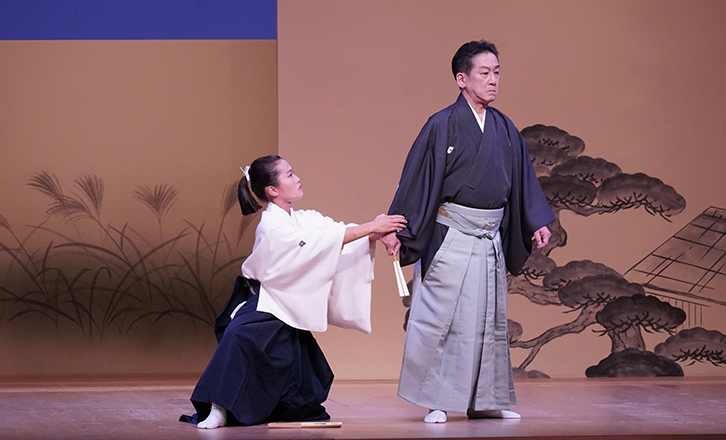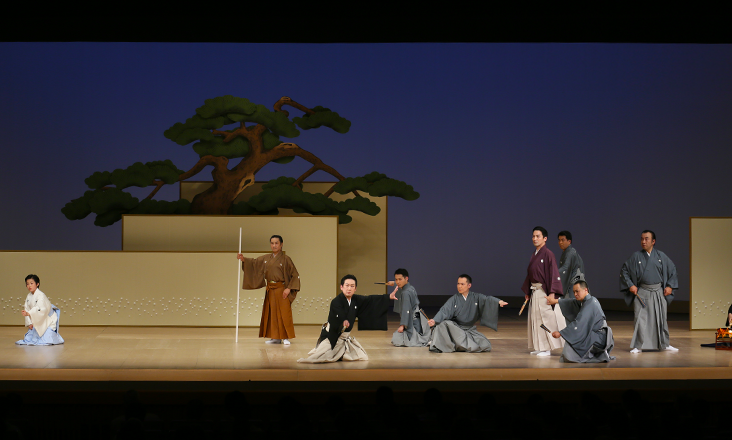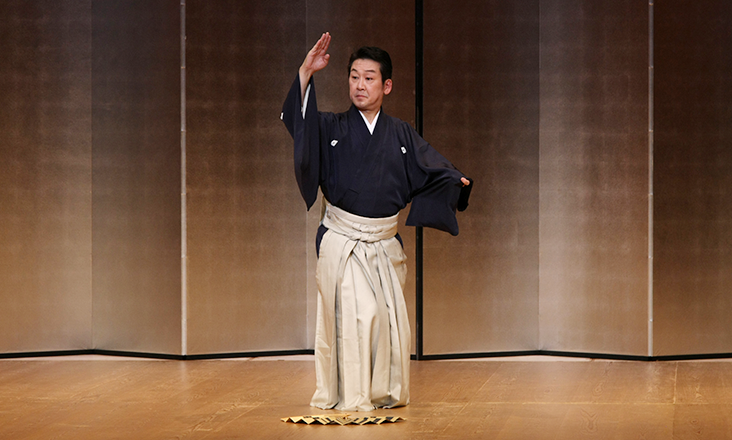Welcome to the
Nishikawa school
On July 29, 2024, I became the eleventh head of the Nishikawa school of Nihonbuyo (Japanese classical dance) and succeeded to the name Nishikawa Senzo XI.
Nishikawa Senzo was my father’s name for over eighty-eight years, while he was the tenth head of the school, and it will take some time before I feel that it has now become my name. My stage name was Nishikawa Minosuke V for the last thirty years, and in parting with that name, I would like to create my own Nishikawa Senzo all the while respecting the image of the name established by my father.
Nihonbuyo is a traditional performing art, and as daily life in Japan has moved away from traditional culture, including the kimono which is worn in Nihonbuyo, the environment surrounding Nihonbuyo has become more and more difficult. However, I believe my duty is to pass on to the next generation what my father and my ancestors preserved and kept alive in Nihonbuyo, a dance form woven with beautiful movements that reflect the soul of the Japanese people
The Nishikawa school has played an important role in the history of Nihonbuyo. Now, let us together, carry forward a traditional aesthetic expression and its charm, established over many years, into this modern age and into the future.
Nishikawa-ryu Souke Nishikawa Senzo XI
The Nishikawa school
It has been over three hundred years since the birth of the first head of the school. The Nishikawa school is one of the oldest schools of Nihonbuyo, and is counted among the five schools that are distinguished for their history and tradition. The successive heads of the school are as follows. They demonstrate the famous words of Zeami (1363? – 1443?), renowned Noh actor and playwright, “An artist’s family lineage (ie) is not inherited by simply continuing the family line. It is inherited by ensuring the proper passing on of the family’s art (gei)” (from Kaden Dai Shichi Besshi Kuden) is a principle that the Nishikawa school has continued to value until today.
-
Nishikawa Senzo I
(year of birth unknown* – deceased 8 June, 1756) *possibly 1698
Second son of a vassal of the shogun or a lord. Accomplished in the Noh theatre’s musical accompaniment (hayashi) and supported Kabuki theatre musical accompaniment, contributing greatly to elevating the status of Kabuki’s offstage geza music. Built the foundation of the school, which later produced famous choreographers.
-
Nishikawa Senzo II
(year of birth unknown* - deceased 21 December, 1789) *possibly 1718
Adopted by the son of the first head of the school. A renowned choreographer whose achievement was establishing the joruri style dance (joruri shosagoto), he created many masterpieces such as “Kuruma jishi” and “Seki no to”. His adoptive father was a master teacher who spread Nihonbuyo among townspeople, but who is not counted as a head of the school since he was not a choreographer.
-
Nishikawa Senzo III
(year of birth unknown – deceased 2 August, 1822)
Nishikawa Kumanosuke, an apprentice of the second head of the school. Demonstrated his talent in choreographing the popular henge style dance (henge mono), and worked on notable pieces characterized by refinement and elegance such as “Tenarai ko”, and with Fujima Kanbei III, “Hana guruma iwai ogi”.
-
Nishikawa Senzo IV
(year of birth unknown* – deceased 2 March, 1845) *possibly 1792 or 1797
Adopted child of the third head of the school, former name Fujima Kansuke. Choreographer for the three licensed theatres in Edo (Tokyo) and their substitute theatres. One of the greatest choreographers who created numerous masterpieces including “Tsuri gitsune”, “Mitsu men komori”, and “Kanjincho”. He had many talents and was also known for his teaching, especially in training male apprentices. Established his name firmly in the Kabuki theatre and built the foundation for Nihonbuyo to develop in the modern era.
-
Nishikawa Senzo V
(year of birth unknown – deceased 23 Oct, 1860)
Nishikawa Minosuke, an apprentice of the fourth head of the school. Choreographed large-scale dance pieces such as “Yamanba”, and many fuzoku style dances (fuzoku mono) such as “Awamochi” with Nishikawa Yoshijiro (Hanayagi Jusuke). Concentrated on preserving the tradition of the Nishikawa school, and transmitted the characteristics of the school faithfully.
-
Nishikawa Senzo VI
(uses the name Nishikawa Senzo from 1867 to 1871)
Also known as Fujima Kanemon II. Was adopted, and became the sixth head of the school.
-
Nishikawa Minosuke, posthumously conferred the name Nishikawa Senzo VII
(year of birth unknown* – 17 September, 1898) *possibly 1841
Nishikawa Kokichi, son of the fifth head of the school. Although recognized as the head of the school by his peers, did not use the name Nishikawa Senzo. Moved away from Kabuki choreography, and worked to train women to become teachers of Nihonbuyo, but was unable to seize opportunities and experienced misfortune.
-
Nishikawa Senzo VIII
(born 12 March, 1859 – deceased 6 October, 1923)
Nishikawa Kiohachi, apprentice of the seventh head of the school. Following a period when the school did not have a head, as a woman, she chose not to succeed to the established name Senzo (扇藏) and used a different form of the name (扇造).
-
Nishikawa Senzo IX
(born 25 February, 1907 – deceased 21 November, 1935)
Omura Yasuko, adopted daughter of the eighth head of the school. Became the ninth head of the school at the age of sixteen, but died unexpectedly at the age of twenty-eight.
-
Nishikawa Senzo X
(born 22 June, 1928 – deceased 14 July, 2023)
Omura Koichiro, the eldest son of the ninth head of the school. Later changed his legal name to Nishikawa Senzo. Following the death of his mother, became tenth head of the school at the age of seven. Dedicated himself to the classical repertoire, preserving the classical dance pieces transmitted in the school, and also gained recognition for performing many highly-acclaimed new pieces such as “Shichiki ochi” and “Uri nusu bito”. Known for his kindness and as a man of character, he revived a school that was declining in strength and led it to thrive today.
-
Nishikawa Senzo XI (born 1 February, 1960)
(born 1 February, 1960)
Nishikawa Hitoshi, eldest son of the tenth head of the school. Former name Nishikawa Minosuke. Following his father’s death, became the eleventh head of the school.
Reference: Nihonbuyo Nishikawa-ryu Shi
(Nihonbuyo Nishikawa School History)
Marumo Yuka, former professor at Nihon University and dance critic
About NIHONBUYO
What is NIHONBUYO

NIHONBUYO is roughly divided into three types: Kabuki-buyo (a genre of Kabuki born as Kabuki evolved since its founding), Kamigata-mai (the dances created in the Kyoto-Osaka area), and Buyo, which was created in modern times with the aim of being a departure from Kabuki.
Around the end of the Meiji Period (1868-1912), the playwright and critic TSUBOUCHI Shōyō proposed a reformation of Japanese theaters. As the musical drama representative of the new age in Japan, he recommended the creation of a dance drama, thus spawning the new word Buyo - a combination of the word mai and odori. Originally, mai and odori were two different forms. Mai is characterized mainly by the circling movements of the performer with their feet in continuous contact with the floor, the focus being on the center of the body for artistic expression. Odori is associated with rhythmical movements, with the performer raising their feet high as part of this artistic dance technique. Hence, mai, which had developed mainly in Kamigata, and odori, which used to be performed in Edo (the Tokyo area), were integrated under the name of NIHONBUYO. NIHONBUYO has become popular in terms of its cultural activities in daily life as well through its role of establishing a sweeping new trend in the traditional Japanese performing arts.
Against this backdrop. the Taishō Period(1912-26) experienced the Shin-Buyo movement, which was set in motion to create new works of buyo in contrast to classical buyo and promoted by the day's flourishing female dancers. Thus, separated from the matrix of Kabuki-buyo, NIHONBUYO became independent as a theatrical performing art not bound to cultural activities of daily life. The following Shōwa Period (1926-89) produced a large number of impressive dancers, as the children of ordinary families also aimed to become professional dancers. Since the Taishō Period. the art of buyo has continued to evolve to this day, incorporating the various performing arts and seeking points of contact with the current times - whether inspired by ballet or modern theatrical plays, or adopting the styles of the folk performing arts and group dance structures.
Incidentally, the essential attributes of the traditional Japanese performing arts, such as folding fans and other props, have been considered as yorishiro (an object a divine spirit resides in) and what gives the dance its inherent qualities. Thus, NIHONBUYO has been inherited through the ages with an emphasis on ancient spirituality.
Various Styles of
Performance

In light of this background, the various performance styles of NIHONBUYO came into being, including ishōtsuke, hansu and suodori.
In ishōtsuke, performers dressed for each role dance onstage within a setting that is almost like a Kabuki stage.
In suodori, created with an artistic expression different from Kabuki, dancers clad in simple costumes - not in a disguise for a specific role - perform against only the background of a byōbu (folding screen), basically with no stage setting. This means the dancers depict the world of the piece without the help of ornamentation such as costumes and stage settings. Thus, the rendering of this style is valued as a testimony to the high level of the dancers' skills. In general, kamigata-mai is also performed in such a simple style as suodori.
Hansu, meaning the intermediate between ishōtsuke and suodori, is a style reflecting the images of the roles.
The Appeal of
Expression

The appeal of NIHONBUYO, above all things, lies in the movements representing “masculinity" and “femininity." Male and female styles are characterized by movements such as “the feet are turned outward" and “the feet are turned inward while keeping the arms closer to the body," respectively.
The depictions of the scenery or peoples' daily lives is also distinctive. Among these are forming a flower with a folding fan or the hands; expressing waves by moving a folding fan up and down; representing a bird by flapping costume sleeves: and pretending to drink sake using a folding fan as a cup. All of these are associated with the intentional technique of mitate (using something to express an object or a situation). Furthermore, in some cases a dancer will play multiple roles his or herself. Such rendering is almost never seen in ballet and others, making it one of the great charms of NIHONBUYO. Besides these, there are rhythm-oriented or even almost meaningless movements - all of which are incorporated in NIHONBUYO in a balanced manner.
Also, another charm lies in the rendering to the tunes of the shamisen. The music accompanying the lyrics are written in beautiful Japanese, with the beauty of their individual characteristics constituting a harmonious whole.
A treasure trove of the many appeals of Japan - this is NIHONBUYO!
by ABE Satomi (Dance Critic)
